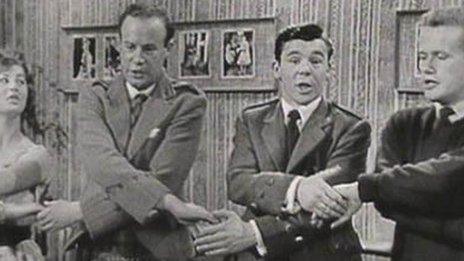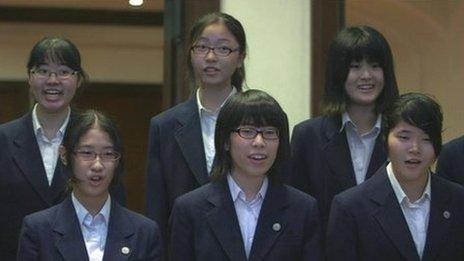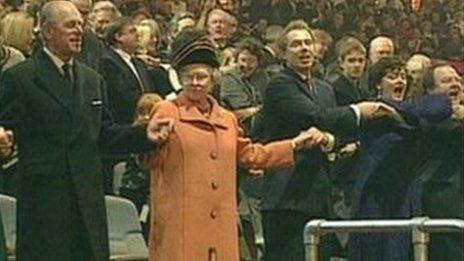How Auld Lang Syne took over the world
- Published

Every New Year's Eve millions of people around the world raise their voices in a chorus of Auld Lang Syne. How did a simple Scottish folk song, with words most people do not know or fully understand, become one of the world's most popular songs?
Changing its tune
Rock star Scottish bard Robert Burns is the man responsible, though he was inspired by fragments of traditional songs from earlier times.

Robert Burns brought us Auld Lang Syne
He wrote the lyrics in 1788 but the tune we know now does not first appear with the song until after his death.
In 1799 Edinburgh publisher George Thomson included the song in his Select Collection of Original Scottish Airs.
Both the words and the tune appear to be based on earlier fragments which Burns "restored" but the power of the two together has become unstoppable.
A million meanings

Andy Stewart always knew when to "gie a hand"
Auld Lang Syne is an international anthem and one of Scotland's gifts to the world.
Burns scholar Thomas Keith says it is a song of reunion not of parting, as some people think.
It recalls happy days gone by, separation and coming back together.
Mr Keith says there is a family and friendship feeling to the song that everybody seems to immediately understand.
"It is something to do with that melody as well as the Burns lyrics, because the lyrics are sometimes known and sometimes not," he says.
So what does Auld Lang Syne mean?
It would translate into standard English as "old long ago" or more colloquially "the good old days". In the modern idiom some might say "back in the day".
It is a tale which looks back at old times with a friend from childhood and seeks to rekindle the past by a handshake and a goodwill drink (a guid willie-waught as Burns would have it).
Scots diaspora

Auld Lang Syne is an integral part of New Year celebrations in America
The song's initial popularity coincided with the age of Scottish emigration, especially to Canada and the US, in the 19th Century.
Its mood of family and friendship - and its good dose of melancholy - stayed in the hearts of the Scottish Diaspora and became stronger and more rooted as it became part of the countries they settled.
US military historian Robbie Wintemute says that during the American Civil War the Union tried to restrain singing of Auld Lang Syne because of the sentiments of returning home and reconciliation.
However, after the signing of the surrender terms, General Grant ordered the band to play it, recognising that the country and the soldiers had been through a tremendous upheaval and that now was a time for healing.
Christmas Day Truce
The international popularity and special significance of Auld Lang Syne was poignantly illustrated during the Christmas Truce at the start of World War 1.
For a brief moment the guns fell silent and troops from both sides left the trenches to swap souvenirs and sing songs.
According to a letter from Sir Edward Hulse, of the Scots Guards, the British and German soldiers joined together to sing Good King Wenceslas, The Tommies Song and finally Auld Lang Syne.
Sir Edward wrote: "It was absolutely astounding and if I had seen it on a cinematograph I should have sworn it was faked."
Hollywood loves it
In the early part of the 20th Century the film industry brought Auld Lang Syne to an even bigger audience.
Charlie Chaplin used Auld Lang Syne for a New Year scene in the Gold Rush, a 1925 silent film which was re-released with a new score, devised by Chaplin, in 1942.
There was not a dry eye in the house when nine-year-old Shirley Temple sang the song to a dying soldier in the 1937 John Ford film Wee Willie Winkie, or during the final scene of Frank Capra's It's a Wonderful Life (1946).
There are hundreds more examples, including the 2008 movie of Sex and the City.
Scottish singer Mairi Campbell's rendition of the song was used in a New Year scene in the hit film, after a special request from its star Sarah Jessica Parker.
Campbell says: "I like the way it was used in the film. I was quite taken aback. The focus leaves the shoes and the dresses and moves into forgiveness and compassion."
The 1989 comedy When Harry Met Sally has this memorable exchange at a New Year's party when Billy Crystal's Harry gets distracted immediately after declaring his love for Meg Ryan's Sally.
Harry: "What does this song mean? My whole life, I don't know what this song means.
"I mean, 'Should old acquaintance be forgot'? Does that mean that we should forget old acquaintances, or does it mean if we happened to forget them, we should remember them, which is not possible because we already forgot?"
Sally: "Well, maybe it just means that we should remember that we forgot them or something. Anyway, it's about old friends."
All around the world

The Japanese version of Auld Lang Syne is something of a school anthem
Auld Lang Syne has been translated into many different languages and is sung in many parts of the world.
In India and Bangladesh, the melody was the direct inspiration for the popular Bengali song "Purano shei diner kotha" (Memories of the Good Old Days) and in Korea, from 1919 to 1948, the lyrics of the national anthem were to the tune, which was introduced to the country by Western missionaries.
Its popularity in Russia stems from an admiration of the people's poet Robert Burns, and in China Auld Lang Syne is so established that many assume it is a native song.
It is popular in farewell parties in Mexico and many European scouting gatherings. The Danes have it as a folk song and the Dutch use it as a tune for their football song "We love Orange".
The Japanese got their hands on Auld Lang Syne in the 1890s when it was introduced into the school curriculum by an American teacher - Luther Whiting Mason - in a wave of Westernisation.
The words were changed but the essence of the song remains. The song they call Hotaru no hikari speaks of remembrance, nostalgia and friendship.
It has become something of a Japanese school anthem and is commonly heard in graduation ceremonies and at the end of the school day. It is also used in stores and restaurants to mark closing time.
It's the New Year Party song
Auld Lang Syne, with its themes of friendship, melancholy and reconciliation, is the perfect New Year song and is sung lustily at gatherings from Edinburgh to New York's Times Square.
But its place as an anthem for 31 December owes much to Guy Lombardo and his Royal Canadian Big Band.
Guy, who recalled hearing the song being played by Scottish immigrants in Canada, was instrumental in fixing it in the consciousness of Americans by playing it on his radio and TV shows which reached millions every New Year from 1929 to 1977.
His broadcast was sponsored by Robert Burns cigars.
Extreme Hokey Cokey

The Queen did not cross her hands for Auld Lang Syne
In the final verse the singer offers his hand of friendship and asks for his old pal's in return.
"And there's a hand, my trusty fiere!/And gie's a hand o' thine!"
The tradition has been that this is the point, and not before, where the hands are crossed and offered to the people on either side of you in the gathered circle.
Scottish singer Eddi Reader says: "The actual physical act of saying 'give me your hand' and then everybody does it, I don't know one other song on the whole planet that makes people do that."
But comedian Fred Macaulay complains about what he calls the "hand fascists" who insist you must wait until the end of the song before joining hands.
Most ignore the "correct" way of doing it, including then Prime Minister Tony Blair when he broke protocol to say to the Queen "gie's a hand" at the Millennium Dome at the turn of the century.
The Queen daintily took the proffered hand but did not cross her hands, waving them gently by her side instead.
And she certainly did not take part in what Fred Macaulay calls the "extreme hokey cokey" which follows, when the enjoined circle runs in and out in a giddy celebration.
It's Syne not Zyne
Finally, when you are belting out the song try to remember that it is Auld Lang Syne with an S not Zyne with a Z.
And while we are at it, the words "for the sake of" Auld Lang Syne are not to be found anywhere in the song.
It does not speak of "in the days of" Auld Lang Syne either.
The verses end with a simple "for Auld Lang Syne" or "and Auld Lang Syne" - although you have to stretch the words a bit to fit the tune.
Happy New Year.